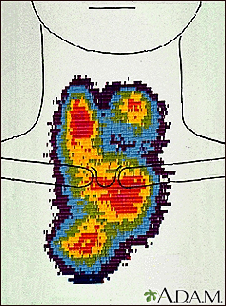Thyroid scan
A thyroid scan uses a radioactive iodine tracer to examine the structure and function of the thyroid gland. This test is often done together with a radioactive iodine uptake test.
Radioactive iodine uptake test
Radioactive iodine uptake (RAIU) tests thyroid function. It measures how much radioactive iodine is taken up by your thyroid gland in a certain time...

How the Test is Performed
The test is done in this way:
- You are given a pill that contains a tiny amount of radioactive iodine. After swallowing it, you wait as the iodine collects in your thyroid.
- The first scan is usually done 4 to 6 hours after you take the iodine pill. Another scan is usually done 24 hours later. During the scan, you lie on your back on a movable table. Your neck and chest are positioned under the scanner. You must lie still so that the scanner gets a clear image.
The scanner detects the location and intensity of the rays given off by the radioactive material. A computer displays images of the thyroid gland. Other scans use a substance called technetium instead of radioactive iodine.
How to Prepare for the Test
Follow instructions about not eating before the test. You may be told not to eat after midnight before your scan the next morning.
Tell your health care provider if you are taking anything that contains iodine because it may affect your test results. This includes some medicines, including thyroid and heart medicines. Supplements such as kelp also contain iodine.
Also tell your provider if you have:
- Diarrhea (may decrease absorption of the radioactive iodine)
- Had recent CT scans using intravenous iodine-based contrast (within the past 2 weeks)
CT scans
A computed tomography (CT) scan is an imaging method that uses x-rays to create pictures of cross-sections of the body. Related tests include:Abdomin...
 ImageRead Article Now Book Mark Article
ImageRead Article Now Book Mark Article - Too little or too much iodine in your diet
Remove jewelry, dentures, or other metals because they may interfere with the image.
How the Test will Feel
Some people find it uncomfortable to stay still during the test.
Why the Test is Performed
This test is done to:
- Evaluate thyroid nodules or goiter
Thyroid nodules
A thyroid nodule is a growth (lump) in the thyroid gland. The thyroid gland is located at the front of the neck, just above where your collarbones m...
 ImageRead Article Now Book Mark Article
ImageRead Article Now Book Mark ArticleGoiter
A simple goiter is an enlargement of the thyroid gland. It is usually not a tumor or cancer.
 ImageRead Article Now Book Mark Article
ImageRead Article Now Book Mark Article - Find the cause of an overactive thyroid gland
Overactive thyroid gland
Hyperthyroidism is a condition in which the thyroid gland makes too much thyroid hormone. The condition is often called overactive thyroid.
 ImageRead Article Now Book Mark Article
ImageRead Article Now Book Mark Article - Check for thyroid cancer (rarely, since other tests are more accurate for this)
Normal Results
Normal test results will show that the thyroid appears to be the correct size, shape, and in the proper location. It is an even gray color on the computer image without darker or lighter areas.
What Abnormal Results Mean
A thyroid that is enlarged or pushed off to one side could be a sign of a tumor.
Tumor
A tumor is an abnormal growth of body tissue. Tumors can be cancerous (malignant) or noncancerous (benign).
Read Article Now Book Mark ArticleNodules absorb more or less iodine and this will make them look darker or lighter on the scan. A nodule is usually lighter if it has not taken up the iodine (often called a cold nodule). If part of the thyroid appears lighter, it could be a thyroid problem. Nodules that are darker have taken up more iodine (often called a hot nodule). They can be overactive and may be the cause of an overactive thyroid.
The computer will also show the percentage of iodine that has collected in your thyroid gland (radioiodine uptake). If your gland collects too much iodine, it may be due to an overactive thyroid. If your gland collects too little iodine, it may be due to inflammation or other damage to the thyroid.
Risks
All radiation has possible side effects. The amount of radioactivity is very small, and there have been no documented side effects.
Women who are pregnant or breastfeeding should not have this test.
Talk to your provider if you have concerns about this test.
Considerations
The radioactive iodine leaves your body through your urine. You need not take special precautions, such as flushing twice after urinating, for 24 to 48 hours after the test because the dose of radioactive iodine is very low. Ask your provider or the radiology/nuclear medicine team performing the scan about taking precautions.
Reviewed By
Sandeep K. Dhaliwal, MD, board-certified in Diabetes, Endocrinology, and Metabolism, Springfield, VA. Also reviewed by David C. Dugdale, MD, Medical Director, Brenda Conaway, Editorial Director, and the A.D.A.M. Editorial team.
Mettler FA, Guiberteau MJ. Thyroid, parathyroid, and salivary glands. In: Mettler FA, Guiberteau MJ, eds. Essentials of Nuclear Medicine and Molecular Imaging. 7th ed. Philadelphia, PA: Elsevier; 2019:chap 4.
Salvatore D, Cohen R, Kopp PA, Larsen PR. Thyroid pathophysiology and diagnostic evaluation. In: Melmed S, Auchus RJ, Goldfine AB, Koenig RJ, Rosen CJ, eds. Williams Textbook of Endocrinology. 14th ed. Philadelphia, PA: Elsevier; 2020:chap 11.
Sipos JA. Thyroid imaging. In: Robertson RP, ed. DeGroot's Endocrinology. 8th ed. Philadelphia, PA: Elsevier; 2023:chap 69.


 All rights reserved.
All rights reserved.